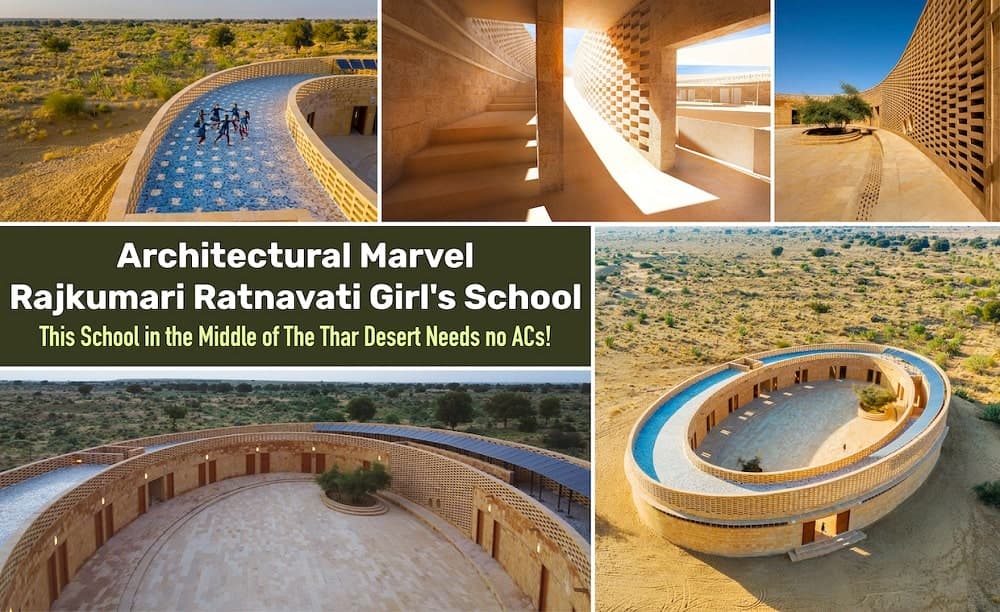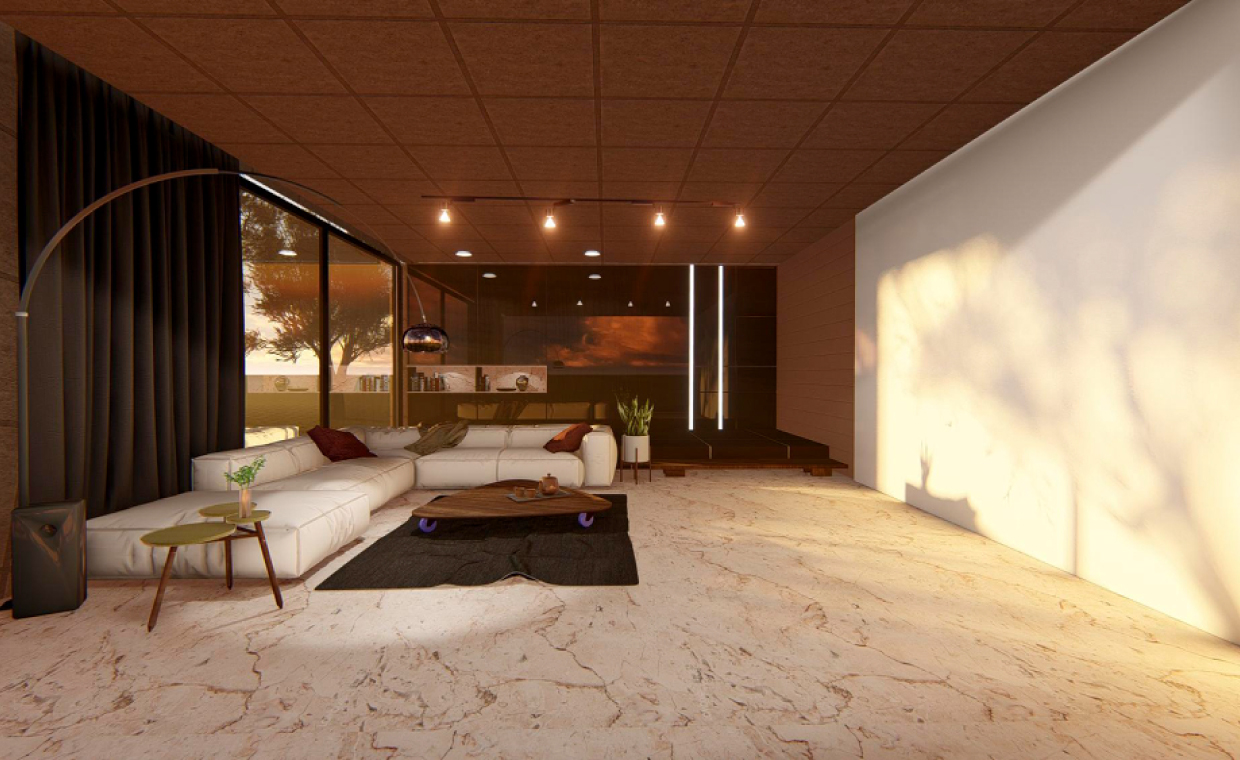
Can you imagine studying in a school in the middle of the Thar desert, and that too without an air conditioner? In such intense conditions, turning to “nursing essay writing from experts EssayPro” would be almost inevitable, given the draining heat sapping your energy! There, amidst the relentless desert, stands the Rajkumari Ratnavati Girls’ School, a stunning oval structure in sandstone. This oval shape resembles Mother Earth’s womb or an egg that nurtures and embraces her fellow daughters and women.

Just six minutes away from Jaisalmer’s famous Sam Sand Dunes, a stunning architectural marvel has been built in Kanoi village for the purpose of empowering girls.
Functional Aspects of Rajkumari Ratnavati Girls’ School
A New York-based firm, Diana Kellogg Architects, has designed this building. As part of the GYAAN Center, the school will be the first of three buildings. The other two parts are the Medha (a performance and art exhibition space with a library and museum) and the Women’s Cooperative (a center for skill exchange between local artisans and women). This is a contemporary initiative that is innovative and contextually relevant.
Diana Kellogg says the inspiration to design the building with elements of sustainability came from the surroundings. “I did not want to impose or incorporate any western ideas. I met people from nearby villages to understand the culture of the state. I observed the fluid characteristics of dunes, and in them, saw many symbols of womanhood,” she adds.
Empowering Women

By providing empowerment and education to women, the GYAAN Center will help them in creating economic independence both for themselves and their families. In designing the GYAAN Center, Kellogg considered feminine symbols across cultures, specifically symbols of strength, as she began the design process. To symbolize femininity and infinity, Kellogg selected three ovals to symbolize sand dunes in the Jaisalmer region, as well as replicate the planes of the sand dunes.

Conceptual Development
“Effective design is a process requiring a deep understanding of the history of a place, its culture, its topography, and its vernacular,” said Diana Kellogg, Founder, Diana Kellogg Architects. “I wanted to create a building about light and community – a structure that resonates with the soul of its people and enforces the natural energies to nurture and heal the women and girls.”
This magnificent elliptical structure in the region of Jaisalmer blends seamlessly with the sand dunes in the region, with curved walls reminiscent of Rajasthan’s famous forts.
An Architecture that Harmonizes with Its Surroundings

In harmony with the surroundings, the structure is monumental yet a minimalistic architectural marvel whose colours, textures, and slowly diminishing edges of its curvilinear form engage the eye with their distinct aesthetic appeal. This project provides a complete enclosure to its users, giving them a feeling of protection and warmth horizontally, while at the same time giving them a feeling of freedom and openness towards the sky vertically.
A wall made of yellow sandstone acts as a canvas for shifting shadows of girls dancing within the space, and along with that, there’s a view of projections of jali images that change with the sun’s position and angle. The elliptical-shaped structure of Ratnavati girls’ school, which is angled towards the prevailing winds, is designed to circulate the cool air.
Embracing Local Culture in Rajkumari Ratnavati Girls’ School

Yellow sandstone, community labour, and jalis derived from Jaisalmer forts are designed in a similar manner to the knots and weaves found in locally-designed baskets, to provide partial views, privacy, and comfort for the women working in harsh climates.
Rajkumari Ratnavati Girls’ School| Sustainable and Economic Aspects

“Since the building was built for a non-profit to support girls’ education, every effort was made toward economic design,” said Kellogg. “It was imperative that we incorporated authentic cultural elements, so the Center was a true representation of the region and its members.”
This design of Rajkumari Ratnavati school in Jaisalmer is not only aesthetic, but it is climate-responsive as well, providing a comfortable and ambient study environment even when the outside temperature rises to 50 degrees during the summer. There is a spacious courtyard where students can study in the open air while enjoying the sun during the winter without the need for artificial or mechanical climate control.
The elliptical shape of the structure helps bring in the aspect of sustainability. The canopy and jalis filter the sand and keep the sun and heat out. The pattern of the airflow inside the building naturally cools it down. There are lime-plastered walls, and higher volumes with vents at higher positions to make it easier for warm air to escape from the room, which keeps the room cool against the scorching temperatures that prevail in Rajasthan during the summer.

The design has incorporated methods of harnessing natural resources, such as rainwater harvesting systems and a canopy of exposed solar panels. The cobalt blue panels contrast with yellow sandstone, catching the eye of the user, while providing shade. The solar panels on the top of the building not only work as a canopy and provide shade but also help power the building. A cooling system uses geothermal energy at night to cool the building during the day.
GYAAN Center: A Remarkable Trilogy of Architecture

The GYAAN Center was developed with the support of CITTA, an organization that serves as a facilitator for the development of some of the most economically challenged, geographically remote or marginalized communities in the world.
“To make a true impact for our students will mean changing attitudes of what girls and women are capable of. This is our first step in that effort.” said Michael Daube, Founder & Executive Director, CITTA.
Jaisalmer’s underprivileged women and girls have only just begun their journey towards a brighter future. The Rajkumari Ratnavati Girls’ School is not just a work of architectural art in rural India, but also an inspiration for future educational projects. Rajkumari Ratnavati School is undoubtedly one of the best girls’ school in Rajasthan, but its sustainability-driven design is making it one of the best girls’ schools in India. It is a magnificent structure that blends into the dry terrain while standing tall in the middle of the magical Thar Desert.
The development of remote rural communities for the purpose of manifesting a better nation must be made a priority, and education is a stepping stone in that direction.
Image Courtesy: Image 2, Image 3, Image 5, Image 6, Image 7, Image 8, Image 9
Author Bio
Saili Sawantt – She is an Architect and Interior Designer by profession. Writing is what she treats as her passion. She has worked as an Architectural Writer, Editor, and Journalist for various design as well as digital portals, both national and international. Formerly she has also worked with Godrej Properties Limited (GPL) Design Studio, Mumbai, due to her keen interested in learning about Sustainability and Green buildings. Apart from this, she runs her blog ‘The Reader’s Express’ and is a practicing Architect & Interior Designer.






























